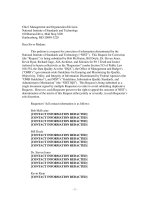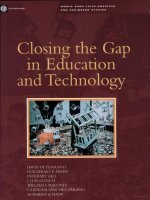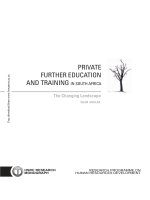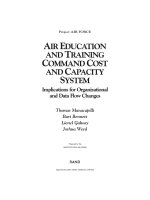- Trang chủ >>
- Đề thi >>
- Đề thi lớp 6
misnistry of education and training vietnam academiy of science and technology
Bạn đang xem bản rút gọn của tài liệu. Xem và tải ngay bản đầy đủ của tài liệu tại đây (362.47 KB, 10 trang )
<span class='text_page_counter'>(1)</span><div class='page_container' data-page=1>
MISNISTRY OF
EDUCATION AND TRAINING
VIETNAM ACADEMIY OF
SCIENCE AND TECHNOLOGY
<b>GRADUATE UNIVERSITY OF SCIENCE AND TECHNOLOGY </b>
<b>LE THI THANH XUAN </b>
<b>SYNTHESIS OF SOME DEEP EUTECTIC SOLVENTS FROM </b>
<b>2-ALKYLBENZIMIDAZOLE, CHOLINE CHLORIDE AND </b>
<b>THEIR APPLICATION FOR EXTRACTION OF OMEGA-3,6,9 </b>
<b>FROM THE FAT OF VIETNAMESE BASA FISH </b>
<b>IN MEKONG DELTA </b>
Major: Organic chemistry
Code: 9 44 01 14
<b>A SUMMARY OF THE DISSERTATION </b>
<b>ON ORGANIC CHEMISTRY </b>
<b> </b>
</div>
<span class='text_page_counter'>(2)</span><div class='page_container' data-page=2>
This dissertation is completed in: Graduate University of Science and
Technology – Vietnam Academy of Science and Technology
Supervisor 1: Ho Son Lam, Asso, Prof. Dr
Supervisor 2: Cu Thanh Son, Dr
This dissertation will be defended by the Committee of Dissertation
Evaluation at institutional level, at Graduate University of Science and
Technology – Vietnam Academy of Science and Technology at…..., 2021
This dissertation could be accessed at:
</div>
<span class='text_page_counter'>(3)</span><div class='page_container' data-page=3>
1
<b>INTRODUCTION </b>
Fish raising industry, especially that of Vietnamese basa fish,
is under strong development in the Mekong Delta, meeting domestic
consumption demand and serving as raw processing materials for
export, promoting the development of Vietnam's seafood industry.
However, we have used Vietnamese basa fish mainly their meat
(fillet) for export and primary fats for the domestic market.
By-products of the processing process such as head, bones, fat, skin...
have not been utilized effectively but used as a fertilizer or animal
feed instead. If there is no appropriate treatment, we will not only
waste the nutrients contained in it, but also leave them as sources of
pollution to the environment.
In recent years, in Vietnam, there have been a large number
of studies on the separation of omega compounds by such methods
as: Hydrolysis of lipids in alkaline environment and urea
precipitation or using the thermal fractionation method at high
level… to improve the economic efficiency of the catfish processing.
However, the projects are only exploratory, without any research
work on separating Omega-3,6,9 compounds from the fatty acid
mixture of Vietnamese basa fish and fish fat. In the world, the
Omega-3,6,9 extraction methods available in research and production
include chromatographic method, enzyme and distillation method,
urea complex precipitation method, super liquid extraction method.
</div>
<span class='text_page_counter'>(4)</span><div class='page_container' data-page=4>
special properties such as non-volatility and no vaporized pressure.
Therefore, they do not pose problems related to fire or explosion, are
safe in transport or to the habitat, as well as biodegradability and
biocompatibility. They can replace toxic solvents, limit
environmental pollution, and are able to be recovered and reused.
They are, therefore, the prioritized elements and used as solvents in
extraction techniques.
Separation of Omega-3,6,9 from the fatty acid mixture as
well as the separation of each type of omega with a green and
low-cost solvent system is a common matter concerned by researchers
and manufacturers. Based on the actual demand for Omega-3,6,9 in
Vietnam, as well as the need to improve the economic efficiency of
Vietnamese basa fish, meeting the high scientific requirements of
separation and enrichment Omega-3,6,9 by using green and
inexpensive solvents, we have proposed the project <i>"<b>Synthesis of some </b></i>
<i><b>deep eutectic solvents based on 2-alkylbenzimidazole, choline </b></i>
<i><b>chloride and their application to extract Omega. 3,6,9 in Vietnamese </b></i>
<i><b>basa fish in Mekong Delta</b>”</i> and it was accepted by the Graduate
Academy of Science and Technology as my graduate dissertation.
* The goals of the dissertation
- Synthesizing deep eutectic solvents based on choline chloride
with the compounds of 2-alkylbenzimidazole / ethylene glycol and
determining their structures.
- Using synthetic deep eutectic solvents to enrich and separate
Omega-3,6,9 from waste fat in accordance with the facrories’
procedure of processing Vietnamese basa fish for export.
</div>
<span class='text_page_counter'>(5)</span><div class='page_container' data-page=5>
3
1. Investigating the composition and fatty acid content of
Vietnamese basa fish by traditional solvents and building the fatty
acid separation process from the by-products gained from the
Vietnamese basa fish fillet processing stages.
2. Experimenting and synthesizing Deep Eutectic Solvent by using:
- Choline chloride with urea and isoforms (methylurea,
thiourea and methylthiourea) to determine their properties.
- 2-Alkylbenzimidazole (2-pentylbenzimidazole,
2-heptylben-zimidazole, 2-octylben2-heptylben-zimidazole, 2-nonylbenzimidazole), and creating
a deep eutectice solvent system ethylene glycol / 2-alkylbenzimidazole.
3. Using the synthetic deep eutectic solvents to separate and
enrich Omega-3,6,9 from raw materials.
4. Comparing the enrichment and separation of Omega-3,6,9 by
the synthesized deep eutectic solvent.
* The scientific and practical significance of the dissertation
Finding out a method of separating and enriching Omega-3,6,9
from by-products of Vietnamnese basa fish with deep eutectic solvents
for high omega content. Making effective use of by-products derived
from processing Vietnamese basa fish for export in Mekong Delta.
</div>
<span class='text_page_counter'>(6)</span><div class='page_container' data-page=6>
<b>CHAPTER 1 </b>
<b>INTRODUCTION </b>
<b>1.1</b> <b>Brief introduction to ionic liquid </b>
<b>1.2</b> <b>Deep eutectice solvent – a new generated liquid (DES) </b>
<b>1.2.1. Brief introduction to DES – formation and development </b>
In the early of 20th<sub> century, a new ionic liquid system was </sub>
generated by mixing quaternary ammonium salt (2-hydroxyethyl
trimethyl ammonium chloride) with several hydrogen-bonding agents
such as amide, glycol or carboxylic acid (mono- diacid). They form a
solvent capable of dissolving several salts and metal oxides, which is
also of low cost and easy to recycle or decompose without polluting
the environment.
This new ionic liquid is called DES (deep eutectic solvent).
The first publications on this ionic liquid system were done by
Abbott and his co-researchers since 2001. To highlight DES's
growing interest in green solvents, C. Andrew and other researchers
sought through the cited database of Web of Science Citation
Database for many research works in the field of DES. When the
compounds making up DES are the main ones, such as amino acids,
organic acids, sugars or choline derivatives, DES is known as deep
natural eutectic solvents (NADES). In terms of physical and chemical
properties, NADES fully feature the green chemical principles.
<b>1.2.2. Scientific background of DES </b>
</div>
<span class='text_page_counter'>(7)</span><div class='page_container' data-page=7>
5
hydrogen bonding interaction between the complexing agent and the
organic salt. Hydrogen bond is a very weak bond formed by
electrostatic attraction between hydrogen (bonded in a molecule) and
a strong electronegative atom of small size (N, O, F ...) in another
molecule or in the same molecule. Hydrogen bonds can be formed
between molecules or within the same molecule.
<b>1.3. Introduction to Vietnamese basa fish and the content of </b>
<b>Omega-3,6,9 in the fish </b>
<i><b>1.3.1. Introduction to Vietnamese bas fish </b></i>
<i><b>1.3.2. Potentialities of Vietnamese basa fish and content of omega </b></i>
<i><b>in the fish </b></i>
<b>1.4. Economic values and application of Omega-3,6,9 in our lives </b>
<i><b>1.4.1. Research works on the pharmaceautical values of omega to </b></i>
<i><b>human beings </b></i>
<i><b>1.4.2. Introduction to fat </b></i>
<i><b>1.4.3. Classification of fat</b></i><b> </b>
<i><b>1.4.4. Introduction to omega </b></i>
<b>1.5. Several extraction methods for Omega-3,6,9 available in </b>
<b>research and production </b>
</div>
<span class='text_page_counter'>(8)</span><div class='page_container' data-page=8>
precipitate to obtain fatty acids including saturated fatty acids and
unsaturated fatty acids with omega content of 24,5% [111]. There are
also authors [112] using traditional solvents to extract omega from
Vietnamese basa fish fat and performing transesterification to
analyze and determine their composition. In general, these claims are
only exploratory, there is no research on separating Omega-3,6,9
compounds from the fatty acid mixture of Vietnamese basa fish by
deep eutectic solvents.
<b>CHAPTER 2 </b>
<b>EXPERIMENTAL PROCIDURES </b>
<b>2.1. Chemical elements, raw materials and experimental tools </b>
<b>2.2. Preparation of Vietnamese basa fish </b>
<i><b>2.2.1. The procedure of material processing </b></i>
Raw materials of Vietnamese basa fish collected from
seafood processing factories in Dong Thap were washed and drained.
Then the fish were cut by following the process by export seafood
factories and 3 parts were obtained, including primary fat, meat
(fillets) and the rest (skin, head, body, organs ...) which were
described as the by-products in the table. We performed three times
of fish cutting procedures to determine the average weight.
<i>Table 2.2. </i>Components of Vietnamese basa fish at the first stage of process
Tra fish Basa fish
No Components Weight
(gam)
Percentage
(%)
Weight
(gam)
Percentage
(%)
1 Primary fat 50 2,3 106 6,06
2 Meat (phile) 816 37,1 615 35,14
3 By-products 1334 60,6 1029 58,8
</div>
<span class='text_page_counter'>(9)</span><div class='page_container' data-page=9>
7
<i><b>2.2.2. The methods of fat extraction from the by-products </b></i>
The by-products were added with water and boiled for 60
minutes, then they were allowed to cool and cooled. The fat obtained
from the by-product was separated and put under serial extraction
times with the n-hexane-methanol solvent system.
Methylation: The jelly obtained after extraction was
methylated with methanol and concentrated sulfuaric acid was used
as catalyst with the ratio of extracts/Methanol/Catalytic 50gam/
100gam/1gam. The esterification was carried out in a 200 ml glass
flask, with reflux condenser attached for 3 hours under stirring
condition and heated to 60 °C by magnetic equipment. The product
was vacuum-evaporated at 35 °C to remove excess methanol, then
washed several times with distilled water and anhydrousized with
Na2SO4. Samples were analyzed by GC/FID to determine the
chemical composition and kept intact for later Omega-3,6,9
separation studies.
<b>2.3. The Deep Eutectic solvents we synthezied and used for the </b>
<b>dissertation</b>
The deep eutectic solvents synthesized for enriching and
separating Omega-3,6,9 from the fat extracted from by-products in
Vietnam basa fish are introduced in the table below.
<i>Table 2.3</i>. The ratio of DES weight
DES GENERATION Ration of weight (g/g)
Methanol/Urea (Sample 1, Sample 2, Sample 3,
Sample 4) 1:(0,14; 0,2 ; 0,23; 0,25)
Choline chloride/urea (Ch/U) 1:1
Choline chloride/methylurea (Ch/MU) 1:1
</div>
<span class='text_page_counter'>(10)</span><div class='page_container' data-page=10>
<b>2.4. Synthesis of DES on the basis of choline chloride / urea and </b>
<b>congeners </b>
The method of synthesizing DES liquid based on choline
chloride was done as follows: Choline chloride and urea were put
into a heat-resistant glass beaker placed on a heated magnetic stirrer
in the ratio 1:1, 2:1. and 1:2 by mass and was heated at 60-70 °C with
stirring until a homogeneous liquid was obtained. Experiments
showed that only samples with choline chloride / urea mass ratio 1:1
and 2:1, remained liquid after cooling. The 1:2 (more urea) sample
was recrystallized. Therefore, we only used samples with 1:1 ratio in
follow-up studies for urea isomers of methylurea, thiourea,
methylthiourea (general ratio 1:1).
<b>2.5. Synthesis of 2-alkylbenzimidazole and DES (ethylene glycol/ </b>
<b>benzimidazole) </b>
<b>2</b><i><b>.5.1. Synthesis of</b></i> <i><b>2-alkylbenzimidazole and DES (ethylene glycol/ </b></i>
<i><b>benzimidazole) </b></i>
The reaction was performed between o-phenylenediamine
and carboxylic acid in a ratio of 1:2. The amount of catalyst applied
Choline chloride/methylthiourea (Ch/MThi) 1:1
</div>
<!--links-->









